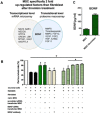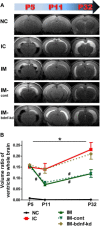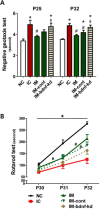Pivotal Role of Brain-Derived Neurotrophic Factor Secreted by Mesenchymal Stem Cells in Severe Intraventricular Hemorrhage in Newborn Rats
- PMID: 27535166
- PMCID: PMC5657690
- DOI: 10.3727/096368916X692861
Pivotal Role of Brain-Derived Neurotrophic Factor Secreted by Mesenchymal Stem Cells in Severe Intraventricular Hemorrhage in Newborn Rats
Abstract
Mesenchymal stem cell (MSC) transplantation protects against neonatal severe intraventricular hemorrhage (IVH)-induced brain injury by a paracrine rather than regenerative mechanism; however, the paracrine factors involved and their roles have not yet been delineated. This study aimed to identify the paracrine mediator(s) and to determine their role in mediating the therapeutic effects of MSCs in severe IVH. We first identified significant upregulation of brain-derived neurotrophic factor (BDNF) in MSCs compared with fibroblasts, in both DNA and antibody microarrays, after thrombin exposure. We then knocked down BDNF in MSCs by transfection with small interfering (si)RNA specific for human BDNF. The therapeutic effects of MSCs with or without BDNF knockdown were evaluated in vitro in rat neuronal cells challenged with thrombin, and in vivo in newborn Sprague-Dawley rats by injecting 200 μl of blood on postnatal day 4 (P4), and transplanting MSCs (1 × 105 cells) intraventricularly on P6. siRNA-induced BDNF knockdown abolished the in vitro benefits of MSCs on thrombin-induced neuronal cell death. BDNF knockdown also abolished the in vivo protective effects against severe IVH-induced brain injuries such as the attenuation of posthemorrhagic hydrocephalus, impaired behavioral test performance, increased astrogliosis, increased number of TUNEL cells, ED-1+ cells, and inflammatory cytokines, and reduced myelin basic protein expression. Our data indicate that BDNF secreted by transplanted MSCs is one of the critical paracrine factors that play a seminal role in attenuating severe IVH-induced brain injuries in newborn rats.
Figures







Similar articles
-
Brain-derived neurotropic factor mediates neuroprotection of mesenchymal stem cell-derived extracellular vesicles against severe intraventricular hemorrhage in newborn rats.Stem Cells Transl Med. 2021 Mar;10(3):374-384. doi: 10.1002/sctm.20-0301. Epub 2020 Dec 15. Stem Cells Transl Med. 2021. PMID: 33319929 Free PMC article.
-
Human UCB-MSCs treatment upon intraventricular hemorrhage contributes to attenuate hippocampal neuron loss and circuit damage through BDNF-CREB signaling.Stem Cell Res Ther. 2018 Nov 21;9(1):326. doi: 10.1186/s13287-018-1052-5. Stem Cell Res Ther. 2018. PMID: 30463591 Free PMC article.
-
Critical role of vascular endothelial growth factor secreted by mesenchymal stem cells in hyperoxic lung injury.Am J Respir Cell Mol Biol. 2014 Sep;51(3):391-9. doi: 10.1165/rcmb.2013-0385OC. Am J Respir Cell Mol Biol. 2014. PMID: 24669883
-
Mesenchymal stem cells transplantation for neuroprotection in preterm infants with severe intraventricular hemorrhage.Korean J Pediatr. 2014 Jun;57(6):251-6. doi: 10.3345/kjp.2014.57.6.251. Epub 2014 Jun 30. Korean J Pediatr. 2014. PMID: 25076969 Free PMC article. Review.
-
Mesenchymal Stem Cells: The Magic Cure for Intraventricular Hemorrhage?Cell Transplant. 2017 Mar 13;26(3):439-448. doi: 10.3727/096368916X694193. Epub 2016 Nov 30. Cell Transplant. 2017. PMID: 27938484 Free PMC article. Review.
Cited by
-
Mesenchymal Stem Cells Transplantation in Intracerebral Hemorrhage: Application and Challenges.Front Cell Neurosci. 2021 Mar 24;15:653367. doi: 10.3389/fncel.2021.653367. eCollection 2021. Front Cell Neurosci. 2021. PMID: 33841103 Free PMC article. Review.
-
Thrombin Preconditioning Enhances Therapeutic Efficacy of Human Wharton's Jelly-Derived Mesenchymal Stem Cells in Severe Neonatal Hypoxic Ischemic Encephalopathy.Int J Mol Sci. 2019 May 20;20(10):2477. doi: 10.3390/ijms20102477. Int J Mol Sci. 2019. PMID: 31137455 Free PMC article.
-
Promoting neuroregeneration after perinatal arterial ischemic stroke: neurotrophic factors and mesenchymal stem cells.Pediatr Res. 2018 Jan;83(1-2):372-384. doi: 10.1038/pr.2017.243. Epub 2017 Nov 1. Pediatr Res. 2018. PMID: 28949952 Review.
-
A Preview of Selected Articles.Stem Cells Transl Med. 2018 Dec;7(12):839-841. doi: 10.1002/sctm.18-0241. Stem Cells Transl Med. 2018. PMID: 30499243 Free PMC article. No abstract available.
-
The Potentials and Caveats of Mesenchymal Stromal Cell-Based Therapies in the Preterm Infant.Stem Cells Int. 2018 Apr 8;2018:9652897. doi: 10.1155/2018/9652897. eCollection 2018. Stem Cells Int. 2018. PMID: 29765429 Free PMC article. Review.
References
-
- Vohr B.R., Wright L.L., Dusick A.M., Mele L., Verter J., Steichen J.J., Simon N.P., Wilson D.C., Broyles S., Bauer C.R., Delaney-Black V., Yolton K.A., Fleisher B.E., Papile L.A., Kaplan M.D.. Neurodevelopmental and functional outcomes of extremely low birth weight infants in the National Institute of Child Health and Human Development Neonatal Research Network, 1993–1994. Pediatrics 2000;105(6): 1216–26. - PubMed
-
- Ahn S.Y., Chang Y.S., Sung D.K., Sung S.I., Yoo H.S., Lee J.H., Oh W.I., Park W.S.. Mesenchymal stem cells prevent hydrocephalus after severe intraventricular hemorrhage. Stroke 2013; 44(2): 497–504. - PubMed
-
- Park W.S., Sung S.I., Ahn S.Y., Sung D.K., Im G.H., Yoo H.S., Choi S.J., Chang Y.S.. Optimal timing of mesenchymal stem cells therapy for neonatal intraventricular hemorrhage. Cell Transplant. 2016; 25(6): 1131–44. - PubMed
-
- Chang Y.S., Ahn S.Y., Jeon H.B., Sung D.K., Kim E.S., Sung S.I., Yoo H.S., Choi S.J., Oh W.I., Park W.S.. Critical role of VEGF secreted by mesenchymal stem cells in hyperoxic lung injury. Am J Respir Cell Mol Biol. 2014; 51(3): 391–9. - PubMed
MeSH terms
Substances
Grants and funding
LinkOut - more resources
Full Text Sources
Other Literature Sources
Medical
Research Materials

